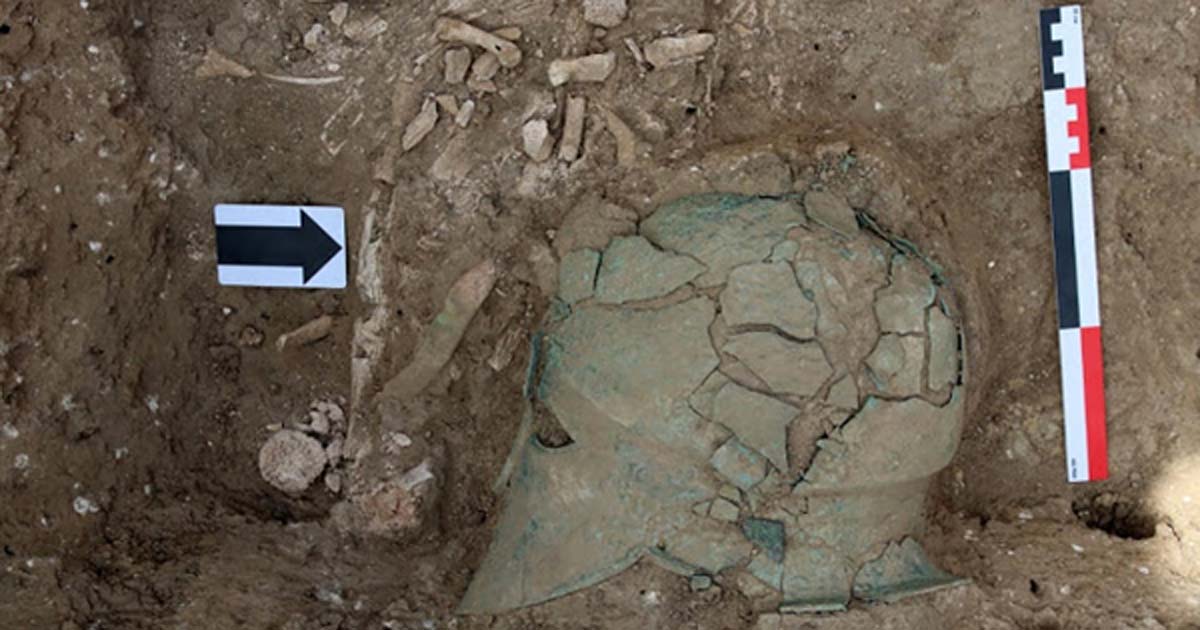First Corinthian Helmet North of the Black Sea Has Been Discovered in Russia
The Russian RIA news agency has reported a remarkable find of an ancient Greek Corinthian helmet. The discovery was made in the Taman Peninsula in the southwest of Russia. The helmet was unearthed during the excavation of a Greek necropolis in the area by the Institute of Archaeology of the Russian Academy of Sciences (IA RAS). The helmet is one of the most remarkable discoveries yet made at this site. The helmet now raises questions as to the nature of Greek society in the ancient Black Sea area and its contacts with the wider Greek world.
Greeks in the Black Sea
Russian archaeologists have been excavating a necropolis of 600 burial mounds in the Taman area for over two years. The burial mounds are related to Greek colonies in the locality and especially that of Phanagoria. The helmet, which has been dated to the 5 th century, comes from an era when the Greeks were establishing a kingdom in the area. This was, known as the Bosphoran Kingdom which had Panticapaeum as its capital and it lasted for over a thousand years. The kingdom was rich and powerful because of trade with nomadic tribes such as the Sarmatians and the Scythians and developed a culture which was influenced by both Greek civilization and the cultures of the Steppes.
- Agesilaus II, King of Sparta and Commander of Warriors
- More Orichalcum, the Atlantis Alloy, Turns Up with Helmets at a Sicilian Shipwreck, What Was its Use?
- Did Ancient Warriors Really Go to Battle Wearing Winged Helmets?

Location of Bosporan Kingdom. (CC BY-SA 4.0)
Corinthian Helmet
The Russian-team led by Roman Mimohod discovered the Corinthian helmet when excavating one of the burial mounds. These first appeared in Greece around the 6 th century BC. They were widely used by Greek hoplites (heavily armed foot soldiers) and were in use for many centuries. Hoplites, when they fought in Phalanxes, would wear this helmet which was considered to offer excellent protection to warriors. It was the custom of the time that a warrior was buried with his helmet and they were prized objects that conferred social prestige on those who possessed one.
They are frequently depicted in art from the time. According to the Greek Reporter, ‘the helmet was of “Corinthian Hermione-type and would date back to the first quarter of the fifth century BC.” This finding is based on the design of the object and is based on comparisons with some of the many other Corinthian helmets that have been unearthed all over the Greek world.

Corinthian helmet from the tomb of Denda. The name of the warrior (Denda) is engraved on the left greave. From a Greek workshop in South Italy, 500–490 BC. (CC0)
The helmet was made of bronze and it covered a warriors’ head and offered protection for the nape of the neck. The helmet had some cheek guards that were known in Greek as paragnathides, they originally had a padded interior to cushion the warrior from blows to the helmet. The helmet that was discovered is in a poor state and is highly corroded. The discovery, despite its relatively poor state, is one that is seen as very important. It is the only helmet of this type that has been discovered north of the Black Sea and is therefore of great historical significance, notes the Greek Reporter.
- Ancient Sex Curse Revealed: May Your Penis Hurt When You Make Love!
- More Than Metal: Amazing Historical Suits of Armor
- Cataphracts: Armored Warriors and their Horses of War

Overall view of the burial of the Greek soldier with the helmet visible to the right of the photo. Image: Institute of Archaeology of Russian Academy of Sciences
The Greeks at the Black Sea
The find of a Corinthian helmet shows that the Greeks who lived in South West Russia likely adopted hoplite warfare. The discovery also shows that the Greek settlements were still influenced by the culture and societies of the Greek homeland. This would confirm what we know from other sources and discoveries and that they retained a strong sense of Greek identity. This was striking given that according to Tornos News ‘these settlements were in close contact with the Scythian inhabitants of the steppe’’. The necropolis where the helmet was found will hopefully reveal more discoveries that will allow us to better understand the culture and civilization of Greeks who lived on the north shore of the Black Sea.
Top image: Bronze Corinthian helmet found in 5 thcentury BC burial mound in, Taman Peninsula, Russia. Source: Institute of Archaeology of Russian Academy of Sciences
By Ed Whelan

















